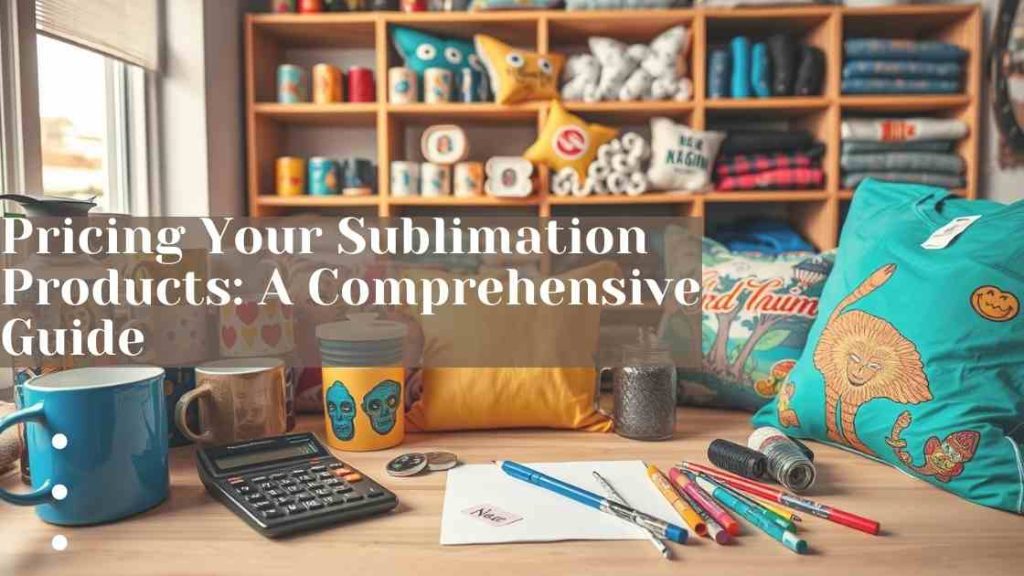Selling sublimation products requires a solid business plan. A key part of this plan is a detailed pricing guide. This guide will show you how to price your products right, so you make more money. Knowing how to price is key for any business, especially for sublimation products.
A good pricing guide for sublimation products covers everything. It looks at costs, market trends, and what competitors charge. By thinking about these things, you can make a pricing plan that fits your business. This guide will help you, whether you’re starting out or improving your strategy.
Key Takeaways
- Developing a solid business strategy is essential for success in the sublimation products market.
- A comprehensive pricing guide is a critical component of your business strategy.
- Understanding your costs, including materials and labor, is vital for effective pricing.
- Market research and competitor analysis are essential for creating a competitive pricing strategy.
- A well-planned pricing guide can help you maximize your profits and grow your business.
- Sublimation products require a unique approach to pricing due to their customized nature.
- A pricing guide should be regularly reviewed and updated to ensure it remains effective.
Understanding the Basics of Sublimation Product Pricing
Sublimation printing is a special way to make customized products with bright, full-color designs. It’s used for many items, like t-shirts, mugs, phone cases, and home decor. What makes these products special is that they can be customized with detailed designs, making each one unique.
The process of sublimation printing is what makes these products stand out. It uses heat and pressure to transfer dye onto materials, creating a permanent, full-color image. This high level of detail and precision is why people love these products so much.
What Makes Sublimation Products Unique
Several things make sublimation products unique. The variety of materials used, the range of designs possible, and the durability of the products are key. These factors together offer a value that’s hard to find elsewhere.
The Value Proposition of Sublimation Items
Sublimation items are special because they can be customized and personalized. People are willing to pay more for products that show their individuality and style. This makes sublimation products a great way for businesses to offer unique, high-value items.
Key Pricing Factors to Consider
When setting prices for sublimation products, several factors are important. These include the cost of materials, the design’s complexity, and the target market. Understanding these factors helps businesses set prices that are both profitable and appealing to consumers.
- Material costs: The cost of the materials used to create the product, such as the substrate and ink.
- Design complexity: The complexity of the design, including the number of colors and the level of detail.
- Target market: The target market for the product, including the demographics and preferences of the target consumer.
By considering these factors, businesses can set prices that meet their target market’s needs while ensuring they make a profit.
Essential Cost Calculation Components
Calculating the cost of sublimation products involves several key components. Accurate cost calculation is vital for setting profitable prices. You’ll need to consider material costs, like the cost of blank products, ink, and paper. These costs can change based on the type and quality of materials.
Other important factors include labor costs and equipment depreciation. Labor costs cover the time and effort in designing, producing, and packaging. Equipment depreciation is the wear and tear on your sublimation equipment. Don’t forget to include business expenses like marketing and overhead costs in your calculation.
Here are some key components to include in your cost calculation:
- Material costs (blank products, ink, paper)
- Labor costs (design, production, packaging)
- Equipment depreciation (sublimation equipment)
- Other business expenses (marketing, overhead)
By considering these essential cost calculation components, you can price your sublimation products right. Make sure to regularly review and update your cost calculation. This helps you keep up with any changes in sublimation costs or business expenses.
Material Costs and Supplies Breakdown
Understanding material costs is key for businesses to save money. Sublimation products have several costs. These include blank product costs, ink and paper, and equipment depreciation.
A supplies breakdown helps figure out the total cost of sublimation products. It includes the cost of blank items like t-shirts and mugs. Also, ink, paper, and equipment depreciation costs are important.
Blank Product Costs
The cost of blank products varies. For example, a high-quality t-shirt costs more than a lower-quality one. Businesses need to think about these costs when setting prices.
Ink and Paper Expenses
Ink and paper costs are also important. The price depends on the type and quality. Businesses should consider these when setting prices.
| Component | Cost |
|---|---|
| Blank Product | $5-$10 |
| Ink and Paper | $2-$5 |
| Equipment Depreciation | $1-$3 |
By understanding supplies breakdown and material costs, businesses can set better prices. It’s important to keep track of equipment depreciation to stay accurate.
Time and Labor Calculations
To figure out the time and labor needed for sublimation products, you must look at labor costs and productivity. This means knowing how long each step takes, from design to packaging.
The skill and speed of your team greatly affect time and labor costs. As your team gets better, they work faster, cutting down on costs per item.
- Streamlining your production process to minimize waste and reduce production time
- Investing in automated equipment to increase efficiency and reduce manual labor
- Providing ongoing training and support to your team to improve their skills and productivity
By managing your time and labor costs well, you can boost your business’s productivity and profits.
Market Research and Competitor Analysis
To do good market research and competitor analysis, you need to know the current trends and what makes you special. You should look at local prices, check online stores, and study your rivals. This helps you set your prices right and stand out in the market.
Understanding your audience and their wants is key. It shows you where you can be different. Looking at what your competitors do helps you plan better. By mixing these, you can create a unique selling point that makes your business stand out.
Key Steps in Market Research and Competitor Analysis
- Identify your target audience and their needs
- Analyze local market rates and trends
- Research online marketplaces and competitors
- Gather data on your competitors’ strengths and weaknesses
- Develop a unique selling proposition
By following these steps, you can do great market research and competitor analysis. You’ll set prices that show off what makes you special. Always keep an eye on your audience and market trends to stay ahead.
Having unique selling points is key to standing out. By knowing your strengths and weaknesses, you can create a plan that highlights your value. This attracts and keeps customers, helping your business grow.
Pricing Your Sublimation Products: A Comprehensive Guide to Profit Margins
To find the best profit margins for your sublimation products, you need a detailed pricing guide. You must think about material costs, time, and labor. Knowing these well helps you set prices that meet your business goals and customer needs.
When figuring out profit margins, remember the special needs of sublimation products. These products need special tools and materials, which raise costs. By adding these costs to your pricing, you can make a profit while staying competitive.
Here are some important things to think about for profit margins:
- Material costs: Add up the costs of blanks, ink, and paper.
- Time and labor: Include the time for designing, printing, and processing.
- Equipment depreciation: Think about the cost of keeping and replacing equipment over time.
By looking at these points and making a detailed pricing guide, you can improve your profit margins. This helps your sublimation business grow and succeed in the long run.
Pricing Strategies for Different Product Categories
When pricing sublimation products, it’s key to look at the product types and their special features. The pricing can change a lot based on the product, its use, and who it’s for.
Custom T-Shirts and Apparel
For custom t-shirts and clothes, prices depend on material, labor, and equipment costs. The design’s complexity, order size, and how fast it needs to be done also play a role.
Home Decor Items
Home decor items like mugs, pillows, and blankets need a special pricing method. Prices are set based on how valuable they seem, the material quality, design uniqueness, and who might buy them.
Promotional Products
Promotional items, like water bottles and keychains, aim for high sales volume. Their prices are set to encourage big orders and keep them competitive.
Important things to think about when pricing different products include:
- Material costs and supply chain expenses
- Time and labor needed for making them
- Who might buy them and how much they’re willing to pay
- What others are charging and market trends
By knowing what makes each product unique and pricing them wisely, businesses can make more money and stay ahead in the market.
| Product Category | Pricing Strategy |
|---|---|
| Custom T-Shirts and Apparel | Cost-based pricing with considerations for design complexity and order size |
| Home Decor Items | Value-based pricing with considerations for material quality and design uniqueness |
| Promotional Products | Volume-based pricing with discounts for bulk orders and competitive pricing |
Seasonal Pricing Adjustments
To make more money, knowing about seasonal pricing is key. Businesses can use demand fluctuations to their advantage. They can raise prices when demand is high and keep prices low when it’s not.
Some important things to think about for seasonal pricing are:
- Figuring out when demand is highest and lowest
- Using demand fluctuations to set prices
- Watching what competitors charge
By adjusting prices based on seasonal demand, businesses can stay ahead. They might offer deals in slow times to get more sales. Or, they could raise prices when demand is high to make more money.
For instance, a company selling sublimation products might see more sales in summer. This is because people want custom clothes and accessories then. By changing prices with the seasons, the company can make more money.
The secret to good seasonal pricing is to keep an eye on demand changes. Then, make smart price changes to boost profits and stay competitive.
Building Value Through Premium Pricing
Premium pricing is key in the sublimation product world. It’s about showing quality, brand, and service. This way, businesses can charge more and attract high-end customers. It helps them stand out and keep customers coming back.
Quality is everything in sublimation. Products differ a lot in materials, design, and quality. By highlighting their top-notch products, businesses can draw in customers looking for the best. Brand positioning is also vital. It sets a company’s image and values in customers’ minds. A strong brand can make premium pricing seem worth it.
Key Strategies for Premium Pricing
- Emphasize quality differentiation to justify higher prices
- Develop a strong brand position to establish reputation and values
- Integrate customer service to build loyalty and trust
These strategies help businesses create value with premium pricing. They attract customers ready to pay more for quality sublimation products.
Premium pricing is about making customers see the value. By focusing on quality, brand, and service, businesses can build a strong base. This leads to growth and success over time.
Online vs In-Person Sales Pricing
When it comes to pricing, online sales and in-person sales are different. Online, prices are competitive and easy to compare. In-person, it’s about building relationships and giving personalized experiences.
Customers see value differently online and in stores. Online, they look for low prices and quick delivery. In stores, they want to touch products and get advice from sales reps. Businesses need to know their audience to price right for both.
Here are some tips for pricing:
- Research competitors’ prices online
- Offer personalized experiences and advice in stores
- Be clear and transparent with prices for both online and in-person sales
By understanding the differences between online and in-person sales, businesses can price effectively. This meets customer needs and boosts sales.
Scaling Your Pricing for Bulk Orders
When handling bulk orders, it’s key to find a pricing balance. Offering volume discounts can attract big orders and strengthen customer ties. A tiered pricing system helps keep profit margins high while giving discounts for bulk purchases.
Volume Discount Structures
Discounts for bulk orders can vary by product or customer type. For instance, a 5% discount might apply for orders over 100 units. A 10% discount could kick in for orders over 500 units. This strategy rewards big orders and loyal customers, keeping prices competitive.
Wholesale Pricing Guidelines
Wholesale pricing is vital for selling in bulk to other businesses or retailers. Clear guidelines ensure products are priced right and profitable. Discounts for large orders, long-term contracts, or loyalty rewards are common.
Minimum Order Requirements
Setting minimum order amounts helps keep things profitable. It stops small orders from eating into profits. This way, businesses focus on bigger, more profitable orders.
Scaling your pricing for bulk orders can lead to more sales and stronger customer ties. Always check and tweak your pricing to stay competitive and profitable.
Conclusion: Maximizing Your Sublimation Business Profits
Starting your sublimation business is exciting, but it requires careful attention. Keep an eye on your business profits and watch market trends. Stay ahead of your sublimation business rivals by using smart profit maximization strategies.
Listen to what your customers want and try new products. Adjust your prices to fit the market’s needs. Use what you learn from market research and competitor analysis to boost your profits. The secret to keeping your business profits up is to stay flexible and creative.
Enjoy the fast-paced world of sublimation and let your love for new ideas push your sublimation business forward. Improve your skills, invest in the latest tech, and give your customers the best service. This way, you’ll stand out as a top player and reach your profit maximization goals.
FAQ
What are the key factors to consider when pricing sublimation products?
When pricing sublimation products, consider material costs, labor, and equipment depreciation. Also, do market research, analyze competitors, and think about unique selling points. Don’t forget to set profit margin goals.
How can I calculate the cost of materials and supplies for my sublimation products?
To figure out material costs, add up the costs of blank products, ink, paper, and equipment. Keeping track of these expenses is key to setting profitable prices.
What role does time and labor play in the pricing of sublimation products?
Time and labor are big factors in sublimation product costs. Calculate labor costs based on productivity. Make sure your workflows are efficient to keep production costs down.
How can I conduct market research and competitor analysis to price my sublimation products effectively?
Start by looking at local market rates and online marketplaces. Find what makes your products unique. This helps you price them right, meeting customer expectations and industry standards.
What are some effective pricing strategies for different categories of sublimation products?
Pricing varies by product type. For custom t-shirts and apparel, home decor, and promotional items, consider their unique values. This will help you find the best pricing for each category.
How can I adjust my pricing seasonally to maximize profits?
Adjust prices with the seasons to match demand. Raise prices when it’s busy and keep them competitive when it’s slow. This strategy can boost your profits.
How can premium pricing help build value for my sublimation products?
Premium pricing comes from quality, strong branding, and great customer service. Highlight these to charge more and attract customers who see the value.
How do pricing strategies differ for online and in-person sales of sublimation products?
Online and in-person sales need different pricing strategies. Consider customer expectations, shipping costs, and the sales environment for each. This ensures you price right for each platform.
How can I scale my pricing for bulk orders of sublimation products?
For bulk orders, offer discounts, set wholesale prices, and require minimum orders. This keeps profits up while welcoming big orders.



